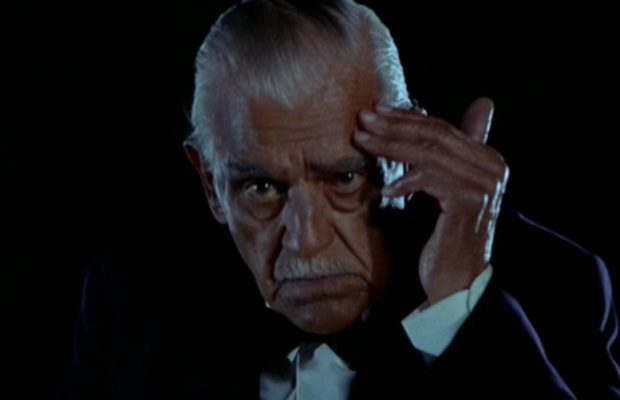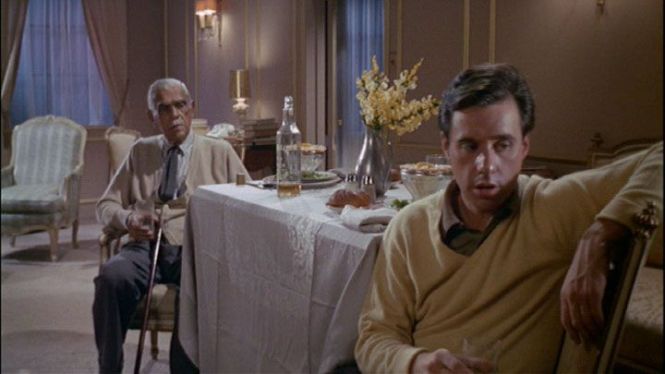Targets (1968)

Toronto Film Society presented Targets (1968) on Sunday, March 3, 2024 as part of the Season 76 Fall Series, Programme 4.
Production Company: Saticoy Productions. Producer: Peter Bogdanovich (uncredited Executive Producer: Roger Corman). Director: Peter Bogdanovich. Screenplay: Peter Bogdanovich (and an uncredited Samuel Fuller), based on a story by Polly Platt and Peter Bogdanovich. Cinematographer: László Kovács. Editor: Peter Bogdanovich. Released Date: August 13, 1968.
Cast: Tim O’Kelly (Bobby Thompson), Boris Karloff (Byron Orlok), Nancy Hsueh (Jenny), James Brown (Robert Thompson Sr.), Arthur Peterson (Ed Loughlin).
Before he became one of the most talked about filmmakers of the 70’s after the release of his incredible masterpiece Last Picture Show, critic turned director Peter Bogdanovich came out with a cult classic: Targets.
Released in 1968, Targets came out in a period of social upheaval in the late 1960s, with widespread protests, political unrest, and increasing violence. Reflecting the anxieties of the era, it offers a sobering commentary on the prevalence of violence in American society.
1968 was the year after the historical start of the revolution of the American cinema that changed the way films were made in the US. Targets was perfectly placed to ride the wave of the new movement that was being born. Bogdanovich, side by side with directors Martin Scorsese, Francis Ford Coppola, Robert Altman, Has Ashby, Alan J. Pakula, and Steven Spielberg, among many others, reshaped the way we, the audience, watched films.
The big, bloated roadshow spectacles like The Sound of Music, My Fair Lady, and the doomed Doctor Dolittle and Hello, Dolly! were a thing of the past. 1967 saw the rise of a new audience, made of young adults who were craving reality, roughness, and creativity, and tired of studio system. Bonnie and Clyde, In the Heat of the Night, and The Graduate kickstarted a new way to make and watch films, a period that is still highly respected and referenced over 50 years later.
Targets is a clear example of what was that movement was all about: a rough around the edges, edgy and thematically ambitious film that gave us a glimpse of the brilliance Bogdanovich would present in the following years.

Intertwining two narrative threads, one centered around Byron Orlok, an aging horror film star contemplating retirement, and the other focusing on Bobby Thompson, a seemingly normal young man who embarks on a killing spree, the film challenges us to follow a narrative style not entirely familiar to most people but also not unfamiliar to those who, like Bogdanovich, have watch Eisenstein and D.W. Griffith. The 50’s and early 60’s were narratively straightforward; Bogdanovich must’ve been inspired by the French New Wave to challenge the perception of what storytelling was all about. Orlok’s story serves as a commentary on the changing landscape of Hollywood and the horror genre, while Thompson’s narrative explores the theme of senseless violence and societal disillusionment.
Bogdanovich employs a variety of cinematic techniques to enhance the film’s mood and atmosphere. The use of stark black-and-white cinematography creates a sense of bleakness and foreboding, while long takes and minimalistic dialogue allow tension to build gradually. The film’s editing, particularly during the climactic sniper sequence, is masterfully executed, heightening suspense, and creating a sense of urgency.
Violence was starting to sneak into the films of the period, which would explode especially with Scorsese’s films and Coppola’s The Godfather. Just a few years later, Altman included another sniper in his masterpiece Nashville. The constant presence of violence, paranoia, and anxieties was a clear indication of the tumbling moment the world was going through at the time, and the pretense that all was fine was not an option anymore. Targets’ exploration of media influence and the desensitization to violence remains relevant today, particularly in an age of mass shootings and widespread access to violent content. The film critiques the sensationalism of violence in cinema and its potential effects on society and raises questions about the responsibility of filmmakers and the ethical considerations of exploiting violence for entertainment.
Produced by Roger Corman in his usual style of little money and fast shooting, it is strangely curious to see how much Bogdanovich was able to infuse in the film with such limited structure behind the scenes. Exploring the different manifestations of fear, from the imagined horrors of Orlok’s films to the real-world violence perpetrated by Thompson, the film suggests that the true sources of fear are often closer to home than we realize. It also manages to address the much talked about generation gap that happened in the period, contrasting Orlok and Thompson, highlighting the disconnect between older and younger generations. Orlok represents the traditional values of the past, while Thompson embodies the nihilism and disillusionment of contemporary youth, exactly how it was happening in the world at the time. Both characters, though, experience feelings of alienation in their respective worlds. Orlok feels out of touch with modern audiences and struggles to find relevance in a changing industry, while Thompson is disconnected from societal norms and resorts to violence as a means of asserting control.
It is particularly interesting to see Boris Karloff in this role. The character of Byron Orlok serves as a reflection of the actor himself, who was known for his iconic roles in classic horror films. Through Orlok, Karloff explores themes of aging, mortality, and the burden of living up to one’s past successes.
The complexities are not exclusive to Karloff’s character; Thompson is a character who defies easy categorization. Initially portrayed as a typical suburbanite, he gradually reveals his inner turmoil and resentment towards the world around him. His transformation into a mass murderer is a chilling portrayal of the banality of evil.
There are many moments during the run of the film that showcase Bogdanovich’s exquisite directing force, right from the opening sequence, featuring Byron Orlok attending a drive-in movie premiere of one of his classic horror films. This scene effectively sets the stage for the film’s exploration of the contrast between Orlok’s fictional world of cinematic horror, and the real-life horrors depicted later in the story.
The most intense and chilling moments of the film revolve around Bobby Thompson’s killing spree. The tension builds as Thompson methodically selects his targets and carries out his acts of violence, culminating in a harrowing sniper attack at a drive-in movie theater. These scenes are particularly memorable for their unflinching depiction of senseless violence and the stark contrast between Thompson’s ordinary appearance and his heinous actions.
The film concludes with a somewhat ambiguous ending that leaves viewers contemplating the implications of the events that transpired. It’s a haunting conclusion that lingers in the mind long after the credits roll.
Targets is regarded as a cult classic and a significant entry in the horror genre. Its innovative blending of psychological thriller elements with real-world horror paved the way for later films that would explore similar themes.
Notes by Leandro Matos










Leave a Reply